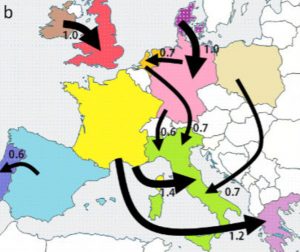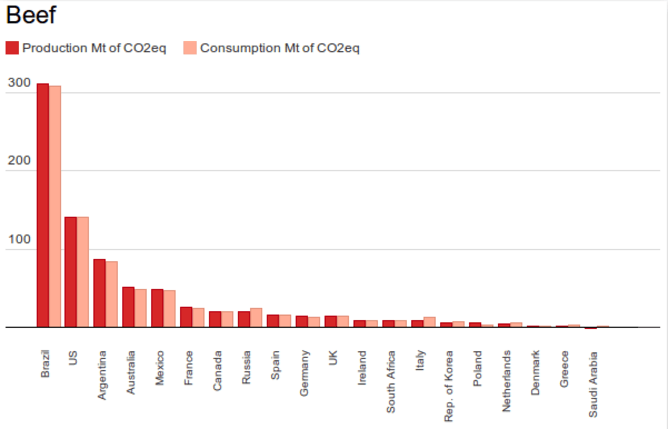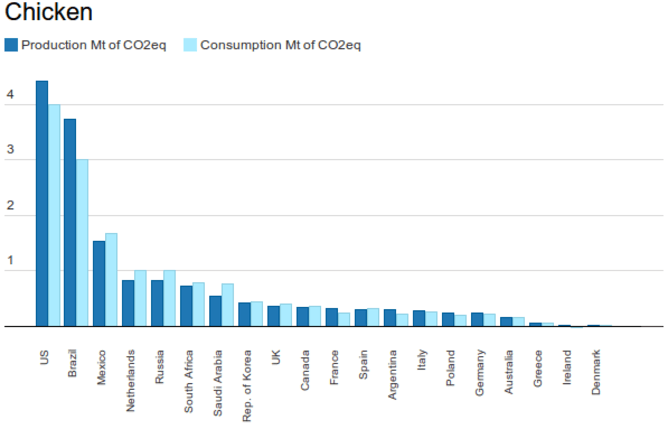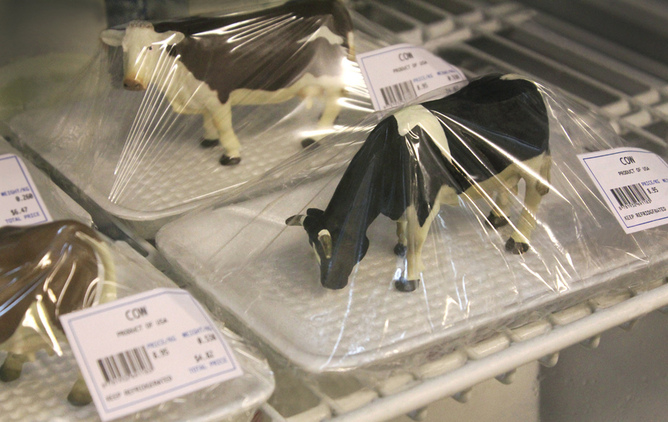Greenhouse gas (GHG) emissions created by humans are a primary cause of global warming. While carbon dioxide emissions from the burning of fossil fuels and changes in land use make up the largest share of these emissions, non-CO2greenhouse gases such as methane (CH4) and nitrous oxide (N2O) contribute substantially to overall warming and livestock – and the meat that we eat – is a big contributor.
The Intergovernmental Panel on Climate Change (IPCC) provides guidelines for estimating livestock emissions on a regional level. Direct emissions of methane and nitrous oxide from livestock worldwide has been recently estimated: they represent about 9% of total GHG emissions caused by human activity. The IPCC guidelines offer a relatively simple and robust accounting for estimating GHG emissions produced in each country.
However, producing countries are not the only ones responsible for emissions: the goods and services being produced are exported for consumption in other countries. In other words, the responsibility for emissions from meat lies with consumers as much as producers.
Alternative accounting
Along with other researchers we have developed alternative accounting systems that re-allocate GHG emissions from producers to consumers. In a study we recently published in Environmental Research Letters, we estimated the total non-CO2emissions from beef, pork and chicken consumption in 237 countries between 1990 to 2010, allocating emissions embodied in trade to countries on the basis of consumer demand for meat.
These emissions were attributed to consumer countries after first estimating the livestock emissions produced by the digestive process that leads to methane release in animals, along with manure management and manure left on pasture in the origin country. We then used data from the new FAOSTAT databaseto work out emissions from the import and export of meat.
The study highlighted the countries with the largest difference between production and consumption emissions and revealed where fluxes of non-CO2 emissions are greatest.
We found that in 2010, 36.1 Mt (millions of tonnes) of CO2-equivalent emissions were related to meat produced in one country but consumed in a different country. Of this total, 72% was methane and 28% was nitrous oxide. In particular, 26.7Mt of CO2-eq (74%), 7.3 Mt of CO2-eq (20%) and 2.1Mt of CO2-eq (6%) emissions related to beef, pork and chicken respectively that were produced in one country and consumed in another.
Although the emissions embodied in traded beef were greater than those of pork or chicken, the emissions from traded beef grew at a slower rate (4%) between 1990-2010 than those related to pork and chicken (81% and 360%, respectively).
Mapping what’s coming and going

Dario Caro/Environmental Research Letters, Author provided
The dominant global fluxes are the export of emissions embodied in meat from Brazil and Argentina to Russia (2.8 and 1.4 Mt of CO2-eq, respectively). Meat exported to Russia embodied 5.2 Mt of CO2-eq emissions; we found that in Russia, 18% of meat-related emissions were traded internationally in 2010. In the same year, emissions embodied in US imports of meat from Canada were equal to emissions embodied in US exports to Mexico: 1.2 Mt of CO2-eq. Australian meat exports to South Korea also embodied substantial emissions: 1.0 Mt of CO2-eq.

Dario Caro/Environmental Research Letters, Author provided
But Figure b reveals that trade among European countries was quite substantial. In particular, meat exported from France to Italy and Greece embodied 1.4 Mt and 1.2 Mt of CO2-eq emissions, respectively. In addition, Italian imports of meat from Poland, Germany and Netherlands embodied 0.7 Mt, 0.6 Mt, and 0.7 Mt of CO2-eq emissions, respectively. We found that in Italy about 30% of meat-related emissions were traded internationally in 2010. Elsewhere in Europe, meat exported from Ireland to the UK embodied 1.0 Mt of CO2-eq emissions.
Globally, percent changes in traded emissions from 1990 to 2010 vary by region and type of meat. The graphs below show the emissions from production and consumption of beef, pork and chicken in several countries in 2010, as well as the percentage change under consumption-based accounting in the same year (negative percentages indicate net export of embodied emissions and positive percentages indicate net import of embodied emissions).
Meat eating and export is going up

Dario Caro et al/Environmental Letters Review/Data Wrappe

Dario Caro et al/Environmental Letters Review/Data Wrapper

Dario Caro et al/Environmental Letters Review/Data Wrapper
We concluded that long-term growth in the international trade of meat since 1990 means that methane and nitrous oxide emissions from beef, pork and chicken produced in one country are increasingly related to meat consumption in a different country. In particular, we found that large transfers of emissions from meat between North American countries, from South America to Russia, and between European countries.
Our findings are important because they quantify the superimposed effects of three important global trends: the growth of international trade; the industrialisation and intensification of meat production; and the increasing consumption of meat.
The overall growth in emissions from the meat trade indicates that the emissions related to increasing consumption of meat are also increasingly disconnected in space from the point of consumption. This spatial disconnect of production and consumption is a challenge for regional or national policies that regulate livestock emissions, because all existing policies neglect any emissions embodied in trade.
The main drivers of meat-related emissions in international trade are the volume and type of meat traded. The trade of beef is the largest source of livestock-related emissions. This is due to the large volume of beef traded internationally and the emission intensity of non-dairy cattle, which is substantially higher than pork and chicken mainly due to greater GHG emissions released during enteric fermentation.
Consequently, beef releases more emissions than pork and chicken per ton of meat traded. Dietary preferences are a strong driver of livestock emissions, with beef generally related to substantially more GHG emissions per ton of meat traded than pork and chicken, and much more than vegetables. Therefore, substituting pork, chicken or vegetables for beef in the diet could reduce livestock emissions.
By Dario Cario, University of California, Davis. Article published in theconversation.com

